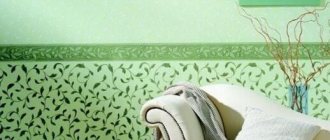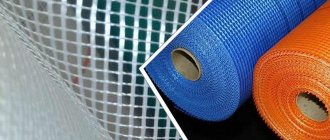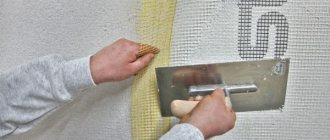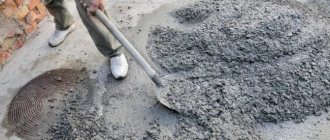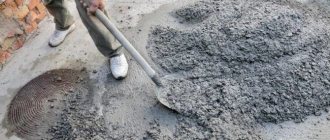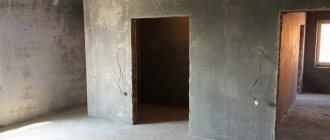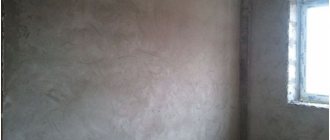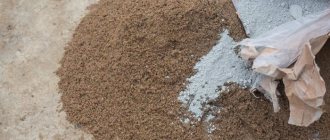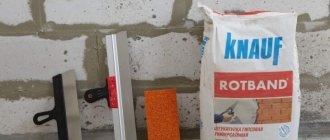Applying plaster is not an easy process. But it is also associated with another problem. This is the definition of such a criterion as the consumption of plaster per 1 m² of wall. Manufacturers of this building material must indicate this parameter on the packaging, but with the condition that the applied layer is 1 cm. We will consider further how to calculate if the required layer thickness is more than this indicator.
Applying plaster to the wall Source i10.fotocdn.net
What should the layer thickness be?
Layer thickness is directly affected by the choice of material you want to use. If your choice fell on the representative of Germany, Rotband plaster, then it has its own specific characteristics:
- layer: ceilings – 5-15 mm, walls 5-50 mm;
- consumption is 8.5 kg, and the layer is 10 mm;
- grain size – 1.2 mm;
- number of liters of solution: 120 l = 100 kg;
- bag weight 5, 10, 15, 30, 50 kg.
Using plaster from the Western manufacturer Knauf, we will continue our example: 8.5 kg (as the norm) * 4 cm = 34 kg. Thus, we have an exact consumption for the wall of 34 kg. To process a wall, we calculate: 10 square meters * 34 kg = 340 kg. As previously written, this type comes in 30 kg bags. We calculate the amount of mixture to purchase: 340 kg: 30 = 11.3333 bags of material. It is best to round up the result by purchasing 12 bags.
Thanks to the examples, you can find out how much material and consumption is required to repair a wall. There are several ways to help accurately calculate material consumption.
Calculating the consumption of Rotband Properties of Rotband plaster
Knauf Rotband
“Rotband” is a popular, affordable and high-quality gypsum mixture, optimal for application by hand. The thickness of the layer should not exceed 5 cm. The amount required to treat 1 m2 with a layer of 1 cm is 8.5 kg.
Buy Knauf Rotband in the online store
Anton Tsugunov , I have been doing repairs and finishing since 2003.
I prefer to buy plaster in an online store - it is very simple, convenient and safe. You can buy plaster without leaving your home. Most often I order delivery directly to the site, so as not to waste time and not “damage” the car.
In the online store you can find the exact specifications and real customer reviews.
Moreover, when I pay for the tiles with my card , I receive cashback of up to 30% of the purchase amount!
It turns out to be a double benefit! I don’t risk my health, I don’t waste time on the road, I receive the paid tiles at the time I specified and also save up to 30%.
Plaster is packaged in 30, 10 and 5 kg
Main types and composition of gypsum plasters
A feature of gypsum plasters is their limited use: they can only be used for interior work. This factor is explained by its natural ability to absorb moisture.
The following surfaces can serve as the basis for gypsum plaster:
- clay walls and ceilings;
- brick-lined surfaces;
- concrete surfaces;
- walls of any size, finished with cement-based plaster;
- renovation of old plaster surface;
- walls made of various types of concrete with a porous surface: foam concrete, aerated concrete or expanded clay concrete.
Gypsum plasters, which contain polymer components, have a shorter drying and hardening period, which significantly reduces the time for repair work.
Volma
Currently, various additives are introduced into finishing mixtures, which give them new properties. To obtain finishing mixtures of a certain type, hemihydrous calcium sulfate, obtained after grinding and firing, is used as a basis.
The most commonly used components are:
- a group of thermal insulating fillers, such as perlite, foam glass, bulk insulation vermiculite, expanded polystyrene (an effective thermal insulator);
- plasticizers that increase the strength of the solution, reduce the setting speed, which ensures its good shrinkage and increases waterproofing properties;
- additives in the form of zinc or titanium white, providing a light tone to the finishing material;
- special additives designed to regulate the setting time of the solution and the time of its complete hardening.
Plaster made from gypsum mixture is included in the class of environmentally friendly building mixtures. In addition, this material regulates indoor air humidity due to its natural hygroscopicity.
In a room with high humidity, such a mixture absorbs its excess, but in a too dry space, the gypsum begins to release the absorbed moisture, saturating the air in the room with it.
Preparation and application
Universal façade plaster SAMIX T-34
- +7 show number +79787139490 Director
- +73652668057
- +73652668606
- +79892605544
| Day | Working hours | Break |
| Monday | 09:00 — 17:00 | |
| Tuesday | 09:00 — 17:00 | |
| Wednesday | 09:00 — 17:00 | |
| Thursday | 09:00 — 17:00 | |
| Friday | 09:00 — 17:00 | |
| Saturday | Day off | |
| Sunday | Day off |
* Time specified for the region: Russia, Simferopol
- +7 show number +79787139490 Director
- +73652668057
- +73652668606
- +79892605544
SAMIX T-34 - Designed for leveling internal and external walls made of concrete, foam and aerated concrete, brick and blocks in dry and wet rooms. It is used for plastering facades (above the base) and in rooms with any humidity (except for “damp” basements). For manual and machine application.
Application area
Dry mixture T34 is intended for leveling internal and external walls made of concrete, aerated concrete, brick and blocks in dry and wet rooms. T34 plaster has good adhesion to the base, frost resistance and high ductility. Can be used for plastering facades (above the base) and in rooms with any humidity (except for damp basements). For manual and mechanized application. The product is economical and high quality, easy to mix and apply, making it profitable and convenient to use. Complies with the hygienic standards in force in Russia.
Preparing the base
The application surface must be hard, clean and dry. Grease, residues of lime and chalk mortars, dust and old paintwork should be removed. The loose and crumbling layer must be eliminated. It is recommended to prime highly absorbent and very dense surfaces (marble, granite, smooth concrete). The base must have a temperature of at least +5C.
Preparation of the solution
Pour the contents of the bag into a container with clean water at the rate of 1 kg of mixture per 0.21-0.23 liters of water (5.25-5.75 liters per 25 kg bag) and mix thoroughly using a construction mixer or drill with a special attachment until obtaining a homogeneous mass. Maintain a technological pause of 5-10 minutes for the solution to mature. Stir again. After this, the solution is ready for use within 3 hours with occasional stirring.
Application Features
The work cannot be called easy. The whole process is divided into successive stages. Ideally, before trying and applying the mortar yourself, it is recommended to watch a video on how to plaster walls with cement-sand mortar. Then, based on what you saw and securing everything with the instructions below, you can do the job correctly.
Required Tools
Plastering with cement is carried out with a standard set of tools. Scroll:
- Trowel or plastering ladle.
- A metal brush to clean the surface.
- Spatulas of different sizes.
- Plumb and level.
- A rule that can be used to control unevenness on walls.
- Grater and polisher to make the surface smooth and remove grooves.
- Container for preparing plaster.
- Bucket for water.
- Roller and brush.
As for materials, a primer for cement plaster will be required to increase adhesion and reduce the ability of walls to absorb moisture.
Preparing the base before plastering
The quality and durability of the created layer will depend on this stage. Sequence of work:
- Remove everything unnecessary from the room.
- Clean the walls down to the base if the old layer falls off.
- If the wall is made of brick, then to improve adhesion they need to be deepened by 1.5 cm.
- When working with a concrete surface, you need to remove its smoothness. To do this, notches or grooves are made on the wall, depth 3 mm, length 15 mm. For 1 m2 you need 250 such notches. The furrows are made with bush hammer or teeth. All that remains is to clean the wall with a brush and wet it with water.
- If the wall is made of wood, then shingles or metal mesh are used to improve adhesion and reinforcement. The shingles are made from 15x4 mm planks, fixed so that diamond-shaped cells are formed. A metal mesh is placed on a clean wall.
After this, you can prepare the material and start working.
Mixture proportions per 1 m2
If you buy finished products, then you do not need to know the cement consumption per 1 m2 of plaster. It is enough to follow all the instructions from the manufacturer indicated on the container. However, when cooking with your own hands, such information is required. This way you can save money on your purchase.
The rate of cement consumption per 1 m2 of plaster can be indicated on the packaging from the cement manufacturer, taking into account a layer thickness of 10 mm. It is different for each brand. To find out the proportions, you need to decide on the layer thickness and increase the indicators on the packaging. Let's take the average consumption for plaster at 8.5 kg/m2. The table below shows what cement consumption is required for plastering at different layer thicknesses:
| Layer thickness (cm) | Mixture consumption (kg) | Consumption of mixture in a bag weighing 25 kg,% |
| 2 | 8.5x2=17 | 17:25=0.68, 68% from the bag |
| 3 | 8.5x3=25.5 | 25.5:25=1.02=102% of the bag, for such a layer you need a little more bag |
| 4 | 8.5x4=34 | 34:25=1.13=136% of the bag, you need to buy two, half of the second will remain |
Cement mortar for plastering walls, the proportions of which have already been discussed above, is created immediately before the start of work, since its lifetime is from 30 minutes to 360 minutes.
Drying time
This determines when you can begin subsequent work, for example, puttying, wallpaper, painting. Complete hardening occurs within 30 days. Then the cement finally gains its strength. But how long it takes for cement plaster to dry on walls is another question. As practice shows, it will take a day for a 1 mm layer to dry. If the layer is 2 mm, then two days, etc.
Plastering
The easiest way is to use the machine method. But it is not suitable for beginners. The work is carried out in 3 layers: spray, primer, covering. The walls can be covered with primer and wait until dry. The best way to make the walls even is to install beacons.
The lighthouse is a smooth guide that defines the plane. It is installed on the wall using putty. Several beacons are fixed at a distance slightly less than the length of the leveling tool - rules (from 60 to 100 cm). Cement plaster for interior work should be applied to the space between the created beacons. First, the spray is applied with a trowel or ladle. The second layer (soil) is applied after the spray has dried. Moving from bottom to top, the mixture is thrown onto the wall. As a rule, moving from bottom to top along the beacons, the surface is leveled, becoming perfectly flat. The excess is removed with a trowel.
At the end, a covering is made to give the surface a smooth finish. When the layer has set, but has not yet dried, it is rubbed with a grater. The room is cleared so that the finish can dry. Now everything is ready to apply the finishing coat.
Example of calculation of plaster mixture
You can calculate the consumption of gypsum or cement plaster in different ways. For example, a cement composition with a bark beetle texture, which is used as a finishing layer in the process of finishing the facade of a house. It is characterized by resistance to moisture and durability, and is economically consumed. The formula is simple: in order to cover 1 square meter it will take 3 kg of solution with a standard layer thickness of 1 cm. To calculate a larger quantity, it is necessary to multiply the standard 3 kg of raw materials by the increased layer thickness.
A cement composition with a bark beetle texture, which is used as a finishing layer in the process of finishing the facade of a house.
We determine the consumption rates of façade plasters per 1 m2
Mineral plaster mixture Ceresit CT 137, thin-layer, decorative (pebble) is used for finishing facade walls insulated with polystyrene foam and mineral wool slabs. Supplied in 25 kg bags. Modifications of filler grain sizes of 1, 1.5 and 2.5 mm are used. If a brick façade wall is being processed, then 1.8 kg of ST 137 (1) will be required per 1 m2; 2.4 kg ST 137 (1.5) and 3 kg ST 137 (2.5).
Decorative plaster ST 35 (bark beetle) with a grain size of 2.5 mm consumes 2 kg, and with a diameter of 3.5 - 3 kg.
Acrylic plasters Ceresit ST 60, 63 and 64 are supplied ready-made in special 25 kg buckets. The average consumption is 2.6-3.8 kilograms per square meter. meter depending on the grain size of the mineral aggregate.
Silicate-silicone decorative plaster Ceresit ST 175. When material consumption per 1 m2, the diameter of the filler is also taken into account. The average value is 2.7 kg per meter of area. Silicone decorative plaster ST 75 is also used for finishing external walls. Consumption per sq. meter is 2.9 kg.
Plaster mixtures based on silicone and silicate-silicone - Ceresit ST 74 and 174. The material is supplied in 25-kilogram buckets in a ready-to-use form. As with other types of plasters, the volume of mixture used per 1 m2 greatly depends on the diameter of the filler. Thus, using the modification ST 174 (1.5) you will need 2.5 kg of the mixture. Whereas external work using ST 174 (2) will require 3.5 kg of solution per 1 m2.
Summarizing the consumption of facade plasters, we can conclude that on average 2 to 4 kilograms of the mixture are required to finish a wall with an area of 1 square meter. This is quite economical with high quality and durability of the resulting surface. In order to reduce the consumption of finishing mixtures, it is recommended to thoroughly treat the wall surface before application. First of all, remove all defects and irregularities and repair cracks. It would be a good idea to apply an acrylic primer, for example, Ceresit ST 16. This will increase the adhesion of the decorative plaster to the surface.
Cement-sand mixture M-150
- The price is presented excluding transport services. Pickup available.
- We will clarify and confirm the order, method of receipt, delivery address within 1 hour during business hours of the online store (from 8:30 to 17:30 Moscow time).
- Characteristics
- Description
- Application area
- Documentation
The dry mixture is used for general construction work such as plastering, construction of walls made of piece building material (brick, concrete blocks and other small elements) and preliminary leveling of the floor base with a layer 10-30 mm thick. It is used for external and internal work in buildings and structures with any type of humidity, as well as in unheated rooms. For manual application.
The universal cement-sand mixture M-150 is a dry mixture based on Portland cement, fractionated quartz sand and modifying additives.
Cement-sand mixture M-150 is produced according to TU 23.64.10-001-86214064-2018 (Magma), TU 5745-001-86214064-2015 (LGOK)
Preparing the base
Before using the mortar mixture, careful preparation of the base is required. The base must be dry and strong, with sufficient load-bearing capacity, free from dust, dirt, oil stains, residues of mineral and organic adhesives, oil and emulsion paints and other substances that can weaken the adhesion strength of the material to the base. The seams, joints and cracks present on the base must be embroidered and sealed with plaster. The cleaned surface must be treated with a primer and work should be done after it has completely dried. Highly absorbent, weak areas of the base are treated with primer twice.
Preparation of the solution
The mortar mixture is prepared at the work site. To obtain a ready-to-use solution, the dry mixture is mixed with clean water at room temperature (30 kg of dry mixture per 3.9 - 4.5 liters of water, 50 kg of dry mixture per 6.5 - 7.5 liters of water). An overdose of water is not allowed, because... reduces the strength of the resulting coating, which leads to further cracking. Mixing the mixture is carried out until a homogeneous mass is obtained throughout the entire volume of the batch using a construction mixer or a drill with a special attachment. The resulting solution must be consumed no later than 120 minutes from the moment of its preparation.
Recommendations for performing work
Work and operation of the coating for three days is carried out at ambient temperatures from +5 to +30°C. The ready-to-use mortar mixture is evenly applied to the surface with a thickness of 10-30 mm and leveled. During the hardening period, rapid drying of the composition should be avoided. It is prohibited to dry the mixture artificially using various types of heating stations: heat guns, lamps, electric fireplaces, etc. The drying time of the mortar mixture depends on the thickness of the layer, as well as on the temperature and humidity conditions of the environment.
Precautionary measures
When mixed with water, the product gives an alkaline reaction. To prevent skin irritation, avoid contact of the solution with exposed areas of the body. When working, use rubber gloves to protect your hands. If the mixture gets on the mucous membrane of the eyes, rinse the area of contact with plenty of running water and consult a doctor. If the room is very dusty, it is recommended to use a respirator and other personal protective equipment.
Packing and storage
Available in bags of 30 and 50 kg. The guaranteed shelf life in undamaged original packaging, subject to all storage conditions, is 12 months from the date of manufacture. Dry mixtures must be stored in packaged form under conditions that do not allow them to be moistened and ensure the safety of the packaging, in covered warehouses with a relative humidity of no more than 60%.
Products using tyrsa
Hyper-pressed brick is a durable building material and is produced from a cement-lime starting mass using a special technology in which there is no firing stage. Hardening of the piece material takes place in special steaming chambers. The binding component is cement; various materials are used as filler, among which tyrsa, which contains a small percentage of clay particles, is widely used. Hard pressed facing brick is used as a facing brick, and the paving option is in demand in the field of landscape design.
Tyrsa is an inexpensive substitute for other bulk materials used in modern road and low-rise construction and the production of finishing materials.
Exterior finishing
What is the consumption of plaster per 1m2.
And so, my dears, today, as you already understand, we will talk about the consumption of plaster, and more specifically about the consumption of plaster or plaster mixture per square meter (1m2). The consumption of the following types of plaster will be considered:
*Which plaster to choose for your home for finishing the walls and ceiling, go to the article
Plaster reviews*, and I will go directly to the consumption of plaster.
| The cost of 1 m2 of applying plaster in the DPR costs 80 RUB. Relevant for cities: Donetsk, Gorlovka, Debaltsevo, Dokuchaevsk, Enakievo, Zhdanovka, Kirovskoye, Makeevka, Snezhnoye, Torez, Uglegors, Khartsyzsk, Shakhtersk, Yasinovataya, Amrosievka, Novoazovsk, Starobeshevo, Telmanovo, Shakhtersk. To order, call - 071-355- 61-05 or 095-896-48-74 You can also knock - After 21:00 only emergency calls are accepted!!! If you haven't answered, call again later! A person is very busy and may not call back due to workload, and your problem will not be solved!!! or 071-355-61-05 or 095-896-48-74 You can also knock - After 21:00 only emergency calls are accepted!!! If you haven't answered, call again later! The person is very busy and may not call back due to his workload, and your problem will not be solved!!!. |
Before you start calculating something and finding out the consumption, in this case it is the consumption of plaster, it is worth knowing how it all is calculated and the final result of the consumption is displayed!
The first step is to measure the area of the intended finishing, the walls there, the ceiling, beacons must be placed along which the plastering will be done. When all this is done, it is worth measuring the smallest thickness of the plaster, the average (approximately), then the largest thickness of the plaster and calculate the average thickness between them. This is done like this:
We take the depth of the plastered plane in three places, add each other and divide by three. This will be the average thickness of the plaster mortar for the entire square footage of your room. After we have obtained the average thickness of the plaster solution on the plane of interest to us, we can calculate the consumption of plaster per 1 m2, but also for the entire room combined, with a difference of ten kilograms! But in this regard, we will also play it safe and take an additional 20% of the result obtained, and so:
– We take the resulting thickness of the plaster, denote it with the Latin letter d and the height of the room with the total length, without deductions for doors and windows, where the height of the plastered surface is L, and the width is h, and multiply them together. The result obtained will be the same plaster consumption per 1m2
in a liquid state. All that remains is to take away 20% of the water. We did not exclude windows and doors from the calculation in order to get 20% of the reinsurance of calculations.
** To avoid making these calculations yourself, go to our online calculator, in which you can easily calculate the consumption of plaster and putty per square meter*.
It is also important to know that the consumption of plaster, especially 1 m2, is influenced by its mixing proportion: water and the plaster itself. Everything must be observed and adhere to the standards according to GOST
Then these calculations will be correct and the plaster* will not shrink, will not be too liquid and will not crack.
Well, let's move directly to the consumption of different plaster.
Consumption of all types of plaster per square meter.
1) Gypsum plaster - consumption per square meter is 9 kg, taking into account that the layer thickness will be 10 mm.
2) Rotband plaster – consumed more than 8 kg per 1 m2 with a plaster layer thickness of 50 mm.
3) The average consumption of decorative plaster per 1 m2 is 9.5 kg, but depending on the type of plaster.
4) Dry plaster – approximately 1-1.5 kg is consumed per 1 m2.
5) The consumption of cement plaster (cement, sand) can be 16-18 kg with a layer thickness of 10 mm.
6) Bark beetle plaster – consumption per 1 m2 will average 2.5-3 kg, creating a layer of 1 mm.
7) The consumption of Volma plaster will be at least per 1 m2 when applying a layer with a thickness of 10 to 11.5 kg.
 The consumption of Venetian plaster in our case is from 80 to 200 g per square meter and again, it all depends on the thickness of the layer.
The consumption of Venetian plaster in our case is from 80 to 200 g per square meter and again, it all depends on the thickness of the layer.
9) Consumption of textured plaster with a minimum application layer of 1.3 kg. per 1 meter square.
10) Vetonit plaster, consumption per 1 m2 will be 1.5 kg with a layer thickness of 1 mm.
11) The plaster consumption is 1.8-2 kilograms, with a layer thickness of 1 mm.
12) Optimist plaster has a consumption of 1 m2 - 1 kg. dry mixture.
13) Lime plaster - consumption per 1 m2, taking into account the application of a 1 mm layer, will be 1.5 kg.
Screed
If the question is asked - how much sand and cement is needed for a screed, then they mainly use grade 400 cement. The ratio of cement and sand is 1:4. The cement consumption for flooring is determined as follows: for a screed of 1 meter square and 10 cm high, one 50-kilogram M400 bag and 200 kilograms of sand are used. Calculation of the required amount of screed is done using the formula:
(Screed area, say 20 m2) * (screed height, and it is translated in meters, and 10 cm = 0.1 m) = volume of the required solution.
To calculate the required amount of sand and cement, it is necessary to divide the volume of the required solution by the number of parts (in this case there are 5) and multiply them by the average weight of a cube of material. For cement, this value is 1300 kg; if the exact weight of sand is not known, then the value is 1625 kg. Shrinkage also occurs in the amount of ¼ of the solution, and the resulting values will need to be multiplied by 1¼.
Due to the fact that plaster performs two functions - decorative and leveling, the calculation of the number of components, including cement, must be done separately in each specific case. Experts recommend a “wall-by-wall” calculation based on the so-called “average thickness of the plaster layer.”
How to calculate?
Calculating the plaster mixture is an important step that should preferably be carried out before starting all work. This will allow you to find out how many bags you will need to purchase to cover one square meter of wall.
Before you begin calculations, you should carefully prepare the foundation. The old coating, which is not firmly attached to them, is removed from the walls.
It is also important to level out any large ridges as they will affect the amount of mortar to be plastered.
The calculation technology involves several sequential actions:
The first step is to determine the degree of curvature. This indicator indicates how much some areas have surface variations. To do this, beacons are placed on the walls, which are leveled using a laser level. They should be attached to the same mortar that will be used for plastering (lime, cement).
To find out the consumption for your specific case per unit area, you simply need to proportionally increase the value depending on how thick the layer is than 1 cm. For example, if you need to lay 2 cm of plaster, then with a consumption of 8.5 kg you will need 17 kg .
This is where the calculation technology ends. All other operations are carried out proportionally depending on the initial characteristics. For example, to calculate 40 sq. m you just need to multiply the previously obtained figure by 40. Thus, you can calculate the volume of material regardless of the number of squares of the wall.
Once you know the total amount of plaster, it is easy to calculate the number of DSP bags that are needed to cover a certain area. To do this, simply divide the entire weight of the mixture by the weight of one bag (in most cases it is 25 kg).
You will learn about important details in the process of calculating plaster by watching the following video.
Calculation method
To obtain accurate indicators, you will need a calculator to calculate wall plaster. The correct result depends on the characteristics and company of the manufacturer, texture, and type of composition.
You must always remember the technical characteristics: proper dilution and application to the surface.
There is a method for determining the amount of raw materials used. It is important to measure the thickness of the layer. The powder is sold in bags with a total weight of 30 kg. For a clear calculation, go to the construction site and find an online calculator. The calculations are simple, be sure to take into account 5% of the mixture reserve: multiply the obtained parameters by 1.05. Information that will be needed:
- Wall parameters (length, height);
- Layer width;
- Weight of packing;
- Variety.
Inaccuracies and irregularities, recesses, depressions affect the final use of the solution and the thickness of the layer. For creativity with decorative plasters, it has the same meaning.
Example: a wall of 10 square meters has deviations in unevenness - 1, 3 and 5 cm. We add three indicators, we get 9. Next, we need to divide by the total number of points: 9 by 3, equal to 3. So, our average layer of the mixture is 3 cm Remember that the minimum values can be up to 1 cm, the maximum - up to 5 cm. This is a standard rule applied at a construction site.
Inaccuracies and irregularities, recesses, depressions affect the final use of the solution and the thickness of the layer.
Features of preparing the solution yourself
The finishing composition is produced in two stages:
- preparation of dry mixture;
- water dilution.
All ingredients are mixed in a wooden, metal, or plastic container of a suitable size with a flat bottom.
Attention: when preparing the pasta, you must ensure that no dry mixture remains in the corners of the box. This may cause lumps to form.
Container for preparing the solution, photo
There are two ways to make plaster. With the manual method, sand is poured into the bottom of the tank, evenly distributing the binder over its surface. The ingredients are mixed with a shovel until smooth, then diluted with water to the required consistency.
Preparing the finishing mixture manually
To mix the ingredients of the paste using a mechanized method, a mixer or concrete mixer is used. All components must be poured into a special container, and then, adding water, mix until smooth.
The solution is mixed mechanically with a special mixer attachment.
The consistency of the plaster depends on the ratio of water and dry mixture. The liquid should be added gradually, thoroughly mixing with the bulk ingredients. The optimal solution for plastering walls is one in which the proportions between the components are correct. If there is a lot of binding material, the result is a fatty mass, which is consumed in large quantities and, when dried, gives sediment and cracks. If the amount of aggregate exceeds the binder, the result will be a lean mass with low strength.
Advice: novice builders are better off using ready-made dry mixtures, which just need to be diluted with water. Their consumption rates and dilution instructions are indicated on the packaging.
The optimal finishing mixture should have the consistency of sour cream
The video will demonstrate how to prepare plaster using a drill:
Division of cement depending on the amount of binder
If the question is how much cement is needed to plaster walls, then it all depends on what kind of solution is needed. As a rule, from 1 to 6 parts of sand are taken for 1 part of cement. The solution is divided according to the amount of sand taken into the part of cement: fatty, thin and normal.
A greasy solution is obtained if the amount of cement is very large. This solution has strong shrinkage and cracks easily (1-3 parts of sand). Skinny ones, on the contrary, have an increased amount of sand per part of concrete, they do not shrink and do not crack (6 = < parts of sand). Normal solutions have an optimal ratio of filler and binder (4-5 parts sand).
Consumption rate
Before starting work, it is necessary to calculate the consumption of the required material. Material consumption rates per 1 m2 of wall depend on the composition of the mixture and the condition of the surface.
By type or manufacturer
Per square meter of improved plaster, 0.0189 is required, and for high-quality plaster, 0.0255 cubic meter of solution is required.
Products from one of the manufacturers
There is a large selection of ready-made mixtures on the market from well-known manufacturers: Knauf, Bergauf. There are also materials from other manufacturers. The most popular compositions with modifying additives and water-repellent properties are produced by Knauf, Bergauf, Hercules.
The name of the plaster itself, consumption and main characteristics are indicated on the packaging. Thanks to this, the amount of material is easy to calculate.
The material consumption is indicated by the manufacturers on the packaging in kilograms per 1 m2.
The video compares various plasters.
The consumption per 1 square meter of Knauf mixture with a thickness of 10 millimeters is 8.5 kilograms, packaging is carried out in bags of 30 kilograms. On average, one bag is enough to plaster with a layer of 1 centimeter 3.5 squares. Knauf also produces gypsum compositions; the amount of plaster per 1 m2 is 8–9 kilograms.
Bergauf cement-based mortar is available in packages of 25 kilograms; the required amount of composition indicated by the manufacturer for a thickness of 10 millimeters is 17 kilograms per 1 m2 of wall.
Ingredient ratio
One 25 kilogram bag will yield a little more than 1 m2 of plaster mortar on the wall, so it is recommended to use it only for finishing.
Hercules dry mortar with cement is packaged in 25 kilograms, the consumption rate of plaster per 1 m2 1 centimeter thick is 16.7 kilograms.
The high price of dry mixtures from well-known manufacturers and the significant consumption of plaster force the use of dry mixtures for finishing operations or luxury plastering. For ordinary finishing, self-prepared solutions are used.
Advantages and disadvantages
No material is ideal for all situations. This also applies to a cement-based composition: it has both advantages and disadvantages.
A coating with this composition is used in the following cases:
- Plastering inside and outside.
- Block wall covering.
- Finishing of concrete structures to improve thermal insulation.
pros
- You can mix it with your own hands.
- The finished surface is resistant to moisture.
- Not afraid of temperature changes.
- Provides stable adhesion to various substrates.
- Provides the highest strength characteristics.
- Finishing is cheaper than other mixtures.
- Can be used for any design.
Work on lighthouses
Minuses
- To ensure strong adhesion to wood, ceramics and structures with paint residues, preparatory work is necessary: priming, notching or applying a mesh for reinforcement.
- The applied layer takes up to a month to gain strength.
- The process is labor-intensive: to achieve the required evenness, the experience and qualifications of the performer are needed.
- The surface requires additional operations: grouting, grinding, priming, puttying.
- Due to its significant weight, it increases the load on the building structure.
- When the building shrinks, cracks may form.
Relevance and benefits
The façade is one of the main impressions made even at a cursory glance. This statement is true for both cozy private houses and commercial skyscrapers. Property owners and architects strive to give it, if not uniqueness, then at least aesthetic appeal. Textured plastering successfully copes with this task by imparting structure, which is complemented by absolute freedom of choice of color shades.
The bark beetle looks organic not only in the exterior, but also in the interior space, which is why it is loved by designers for creative interior ideas for corridors, halls, balconies and even bedrooms.
But still, the impetus for widespread distribution was not so much the beauty of the resulting relief, but rather its pronounced practicality, due to the following:
- Easy to use, thanks to which not only professional builders, but also home craftsmen can cope with plastering;
- Lightness, reducing the load on load-bearing structural elements, especially significant for multi-story buildings;
- Environmental safety achieved by the complete exclusion from technology of toxic substances that can cause poisoning when heated;
- Biological resistance that prevents the development of molds and mosses in the porous structure;
- Heat resistance, maintained for 70 or more freezing cycles and in the temperature range from – 55⁰С to + 60⁰С;
- Immunity to ultraviolet radiation, guaranteeing equal safety on the sunny and shady side in any climate zone, even to the subtropics;
- Long operational period, subject to technical conditions - more than 15 years in indoor spaces and more than 8-9 years in the open air;
- Acid and alkali resistance, allowing wet cleaning, including with non-concentrated detergents;
- Resistant to accidental damage, removing dirt with a brush or vacuum cleaner;
Photo from repaireasily.ru
The listed points, combined with maintaining the technological nuances of the process, guarantee durability, as well as resistance to atmospheric and other damaging agents. And the variability of relief formation methods and extraordinary colors create countless combinations for the most demanding customers.
Best manufacturers and price
The final result also depends on the manufacturer. Little-known companies may produce low-quality raw materials that crack and peel. Therefore, it is better not to save money and choose a good brand.
List of verified companies:
- Cement plaster Knauf (Germany). The company has established itself as one of the best among the creators of building mixtures. The reviews are only positive. Knauf Grünband cement plaster 25 kg is especially praised. Price – 240 rub. per bag.
- Prospectors cement plaster (Russia). Each option complies with GOST standards. The company has been in business since 1992. Prices – 200-220 rubles. per bag 25 kg.
- Cement plaster Ceresit (Germany). Excellent value for money and quality. From 400 to 500 rubles.
Worth mentioning are the Polish company Atlas, the Russian Bolars, Osnovit, Volma, the German Caparol and the Austrian Baumit.
Cement mixture is a universal option for finishing a room. It is affordable, practical, durable, moisture-resistant and effective. Knowing all the intricacies of working with the material, as well as variations, you can complete the finishing efficiently and quickly.
Characteristics
The choice of cement plaster composition for walls is determined by the following features:
- characteristics of the base;
- method of application;
- quality of the applied mixture.
According to the purpose of application, the compositions are divided into categories:
- simple, eliminating irregularities and defects in the base;
- special, containing additives to impart the necessary properties;
- decorative, or finishing, used for finishing.
Cement plaster is widely used and can withstand climatic conditions outside and inside the house.
Surface structure before finishing
Typical consumption of various types of finishing building materials
Depending on the binder, filler and various additives, the compositions are consumed differently (our plaster consumption calculator will help simplify the calculation):
Consumption of different types of plaster
- The consumption of gypsum plaster per 1 square meter, provided that it is applied in one layer, 1 cm thick, is 9 kg.
- Cement compositions are much heavier than gypsum compositions, so 17 kg of plaster per 1 m2 will be required under the specified conditions.
- Decorative finishing materials are used to apply a thin finishing layer, so the consumption of the dry mixture is 8 kg.
- Rotband finishing material usually requires 8.5 kg under the specified conditions.
- Structural mixtures of bark beetles are sufficient at 3 kg per square meter. The small amount is explained by the fact that after drying, not a monolithic structure is formed, but a surface with grooves.
- Volma’s universal solutions, which are suitable for both conventional and hardware application, have a significant mass, so 12 kg of mixture is required per 1 m2 of plaster.
- Venetian coatings can be considered the leader. No more than 200 g of material will be required per square meter of surface.
- On average, all textured solutions are used economically, the average is 1.2 kg per m² of plaster.
- Vetonit brand material will need about 1.5 kg under the specified conditions.
- For the Teplon brand, consumption per 1 square meter increases to 1.8 kg.
- While the consumption of the Optimist solution is 1 kg per square meter.
The presence of deformation in the form of cracks and potholes can increase the consumption of the plaster mixture
Knowing the calculation methods and typical indicators, you can independently calculate the consumption of the plaster mixture for all treated surfaces. The key is to always round up. The remaining mixture can be used to repair the coating or given to someone, but if there is not enough solution, there is a risk that the finishing work will have to be done again
It is also important to remember that the consumption of plaster per 1 m2 of treated surface may increase slightly due to the presence of potholes, cracks and other similar defects. Plaster, the consumption of which is correctly calculated, will cost a reasonable amount
Recommended conditions before starting work
The consumption indicated in the regulatory documentation is relevant for certain environmental conditions both indoors and outdoors. Before starting finishing work, you should make sure that:
- The room temperature is at least 10 C0. Air humidity – no more than 60%.
- The room is ready for plastering. To do this, it is necessary to maintain the nominal temperature in it for 2 days before work and 12 days after.
Preparation and plastering of a brick wall
Only if the above conditions are met, the consumption of plaster per 1 m2 will not exceed that stated in the regulatory documentation.
What does consumption depend on?
In addition to the type, material consumption depends on such an indicator as the curvature of the walls. If the walls of the room being finished deviate noticeably horizontally or vertically, are curved, and also have defects such as chips, fallen areas, etc., then the need for material may increase, sometimes noticeably. To minimize costs in this case, it is recommended to perform preliminary leveling with ordinary, non-decorative plaster.
When choosing a finishing coating, you need to take into account the material consumption and the nature of the walls that you plan to cover. Based on this data, you can calculate how much material is needed to complete the work and plan expenses.
What proportions are they usually diluted in?
When using grade 400 cement, a solution is most often made with a ratio of 1 part cement to 4 parts sand. If you are interested in how much sand is needed in cement 500, then you need to add 5 parts of sand to 1 part of cement. It’s very easy to remember the values: for 400, 4 parts sand, for 500, 5 parts to 1 part concrete. At the same time, to obtain a high-quality solution, one must not forget to take into account that one year of storage: - 100 to the brand of cement. Many people forget about this property of cement.


